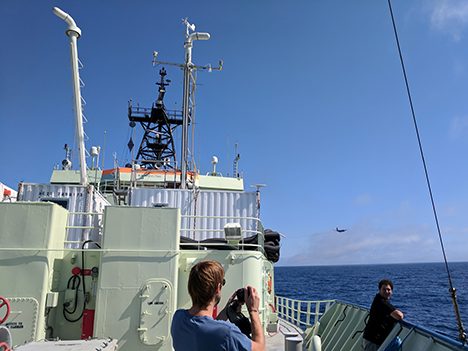The Scripps research group focuses on aerosols, which are microscopic liquids and solids suspended in the air. Aerosols may be formed over the ocean when wave generated bubbles burst and eject particles into the atmosphere. Aerosols may also be formed from gas phase compounds released from the ocean that then react with sunlight and oxidants in the atmosphere. Aerosols are important to climate as they act as seeds for cloud droplets. The ability of water to collect on aerosols is determined by their size and chemical composition. We have several instruments housed in our sampling van that we use to determine these properties. The aerosols are sampled through an inlet that reaches 50 ft above the ocean surface.
The instrument that I work with is an Aerosol Mass Spectrometer (or AMS for short). The AMS provides information on the chemical composition of the aerosols. We typically look at a variety of organic compounds as well as nitrates, sulfates (both from sea salt and organic sulfates formed from dimethyl sulfide released by ocean biology), and other sea salt components (NaCl). The AMS can also determine the sizes of the different aerosol components.
An interesting part of the NAAMES study is linking the atmospheric aerosol measurements with the chemical and physical properties of the ocean being measured by the oceanography teams. These comparisons will help us better understand the processes contributing to aerosol formation over the oceans.
We will also be able to compare our ship-based aerosol measurements with those of the C-130 aircraft. The C-130 can enhance the range of aerosol measurements by flying an accordion shaped pattern around the ship (upwind and downwind), which will let us see how the aerosols measured by the ship change over time. The aircraft will also fly a vertical pattern, which will provide us with information on the vertical profile of the atmosphere. That information is important for understanding the heights and stability (and potential mixing) of the different sub-layers of the troposphere.

The NASA LARGE C-130H Hercules aircraft flyby of the R/V Atlantis on 9/6/2017. The aerosol sampling vans with inlets can be seen on the upper deck (Scripps van on the left, PMEL van on the right).
Written by Derek Price
Tags: NAAMES-III 2017




The aerosol team of scientists is doing amazing work. Looks like amazing weather!